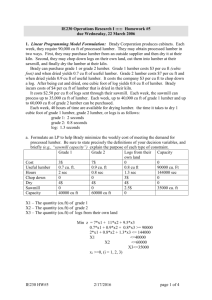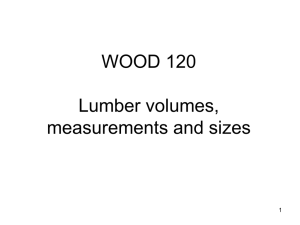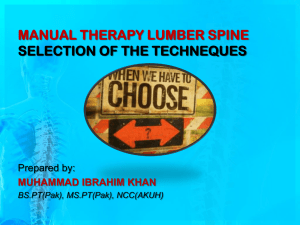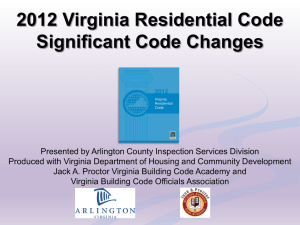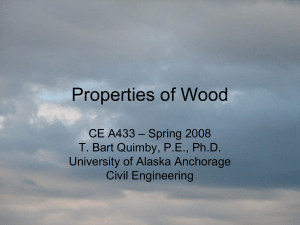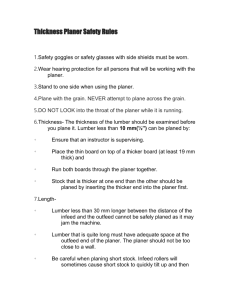Basic Facts of Residential Engineered Lumber
advertisement
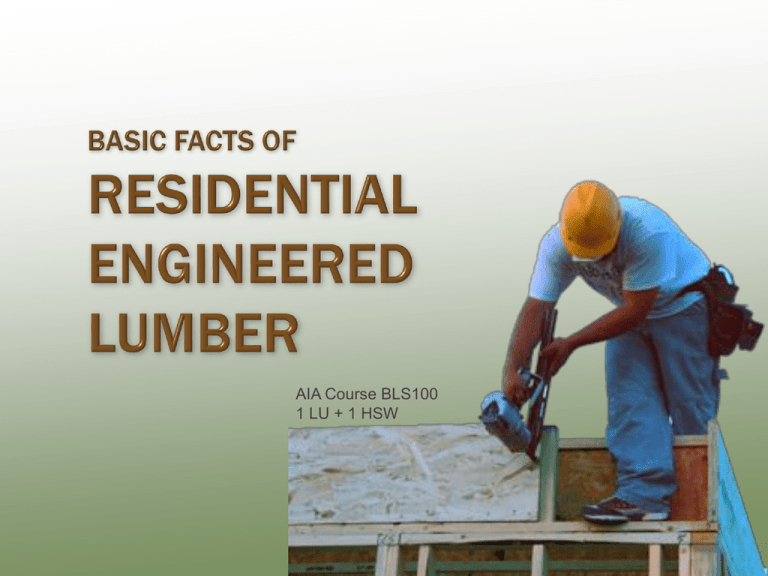
AIA Course BLS100 1 LU + 1 HSW Weyerhaeuser is a Registered Provider with The American Institute of Architects Continuing Education Systems (AIA/CES). Credit(s) earned on completion of this program will be reported to AIA/CES for AIA members. Certificates of Completion for both AIA members and non-AIA members are available upon request. This program is registered with AIA/CES for continuing professional education. As such, it does not include content that may be deemed or construed to be an approval or endorsement by the AIA of any material of construction or any method or manner of handling, using, distributing, or dealing in any material or product. Questions related to specific materials, methods, and services will be addressed at the conclusion of this presentation. Thank you! Recognize the advantages of specifying engineered lumber. Identify common engineered lumber types, including: product composition typical sizes design properties Recognize the common applications for engineered lumber products. Know what to watch out for: special requirements that apply to Engineered Lumber Products. More efficient use of wood fiber, availability, & building trends Predictable design values Dimensionally stable Allows for larger holes to accommodate mechanicals within joist cavities Parallel Strand Lumber Laminated Strand Lumber Laminated Veneer Lumber Wooden I-Joists HEADERS AND BEAMS EXPOSED BEAMS AND COLUMNS EXTERIOR DECK POSTS AND BEAMS HIGH MOISTURE ENVIRONMENTS Widths 2 ” 3 1⁄2” 5 1⁄4” 7" 11⁄ 16 Depths 9 1⁄4” 9 1⁄2” 11 1⁄4” 11 7⁄8” 14” 16” 18” D W * CAUTION! Treated products vary in size and availability by market and manufacturer. Confirm availability before specifying! Column Sizes 3 1⁄2” x 3 1⁄2” 3 1⁄2” x 5 1⁄4” 3 1⁄2” x 7” 5 1⁄4” x 5 1⁄4” 5 1⁄4” x 7” 7” x 7” W2 W1 LARGE LOADS - LONG SPANS - CANTILEVERS/ MULTI-SPAN EXPOSED EXTERIOR - - - Supports heavier loads than comparably sized conventional Glulam or solid-sawn lumber Supports long spans for open floor plans Excellent for cantilever & multi-span applications Exposed PSL beams add aesthetic value Can be treated for exterior uses (regional) HEADERS BEAMS Depths: 5 ½” 7 ¼” 9 ½” 11 7/8” 14” 16” 18” Width: 1 ¾” (common to use multi-ply members) MULTI-PLY APPLICATIONS - STRAIGHT/TRUE - STRENGTH/WEIGHT - PREDICTABLE PERFORMANCE - Up to 4 members can be site-connected No bowing, shrinking, or twisting Supports heavier loads than comparably sized conventional lumber No significant effect from lumber defects HEADERS BEAMS WALL FRAMING ROOF JOISTS COLUMNS RIM BOARD STAIR STRINGERS HEADERS AND BEAMS Widths Widths 1 ¾” 3 ½” Depths 43⁄8” 51⁄2” 71⁄4” 85⁄8” 9 1⁄4” RIM BOARD 1 ¼” 1 1/8” * Depths 9 1⁄2” 11 1⁄4” 11 7⁄8” 14” 16” 9 1⁄2” 11 ½” 14” 16” STUDS Sections 2x4 2x6 1¾” x 5½” 2x8 1¾” x 7¼” Lengths 2x4 – 14’ 2x6 – 22’ 2x8 – 30’ * The lateral load transfer capacity of thinner rim boards is not equivalent to 2" nominal framing and is limited by code to 180 plf. CONSISTENT /UNIFORM - STRAIGHT/TRUE - TALL WALLS - No shimming on headers or studs; eliminates culls Dimensional stability results in solid, straight walls Eliminates the “hinge” point in tall walls CONSISTENT /UNIFORM - No shimming ONE-PIECE HEADERS - Convenient widths STRENGTH (SHORT SPANS) HOLES - - Comparable to conventional lumber for most residential header/beam spans Large hole capacity LONG SECTIONS - STRENGTH - NAILING - Longer pieces for faster installation reducing labor and materials costs Higher diaphragm shear values than 11⁄8" OSB; Stronger than comparably sized conventional lumber Provides a wider nailing surface for subfloor panels; Superior fastener retention minimizes squeaks LSL - Strong LVL - Stronger Most residential loads and spans Thicknesses good for one-piece headers Large hole capability Superior fastener retention minimizes squeaks Warp resistance good for straight walls / tall walls Size for size, stronger than dimensional lumber Reduces aesthetic blemishes (drywall cracks, etc.) Deeper depths Versatile, multi-ply applications Available with water sealant PSL - Strongest Large beams, heavy loads Exposed beams, treated applications Product M.O.E LSL Fb Fv Beam Header 1.3 E 1700 400 1.55 E 2325 310 GOOD BEST LVL 1.9 E 2600 285 BETTER GOOD PSL 2.0 E 2900 290 BEST GOOD FOR LARGE 1.8 E 2400 190 Column/Stud BEST BEST Beams/Header Product LSL LVL PSL I-joist Short span Long span Tall Column Wall Joists Exposed Exterior /Post Stud Rim Stair stringer Flange Web Flange Web FLOORS RIM ROOFS LONG SPANS PREDICTABLE PERFORMANCE - - STRAIGHT/TRUE - STRENGTH/WEIGHT - Can be used for longer spans than comparably sized conventional lumber No significant effect from lumber defects No bowing, shrinking, or twisting Supports heavier loads than comparably sized conventional lumber LOAD LOAD COMPRESSION Zero Stress in Bending TENSION DEFLECTION Load 29 Deflection CAMBER The curvature built into a member usually for the purpose of offsetting sag. Camber 30 Flange and web dimensions and material can vary between manufacturers! ≠ Use the appropriate manufacturer’s proprietary design values and details when specifying. 1-3/4” 1-3/8” 3/8 ” This includes: Span & PLF tables Allowable hole charts Installation & connection details 1-3/4” • 9-1/2” • 11-7/8” 1-1/2” 3/8 ” 2-5/16” • 9-1/2” • 11-7/8” • 14” 1-3/8” 3/8 ” • 9-1/2” • 11-7/8” • 14” • 16” SPAN LENGTH The horizontally projected distance between member supports. Used for Length measured along the member from end to end. Used for ordering material. sizing calculations. Length Clear Span Design Span Out-to-Out Simple Span Span Continuous Span Span Span Nail into plate w/1 [0.131” x 3”] from end into plate DO NOT Nail into plate w/multiple nails Note: Illustration for purpose of example only Up to 4 members can be site-connected Depths 16” and over must include at least two plies Side-loaded beams require additional connection detailing Consult manufacturer’s representative or literature Application MUST be looked at with software ! 45o SLIGHT OFFSET WITH I-JOISTS: Shear transfer through web Web knifing Name some advantages of specifying: Parallel Strand Lumber (PSL) Laminated Veneer Lumber (LVL) Laminated Strand Lumber (LSL) Which engineered wood product is best for: Long-span joists? Exterior column? Short-span header over a kitchen window? Rim? What considerations must be made concerning i-joist floors with walls above? QUESTIONS ? This concludes the American Institute of Architects Continuing Education System Program 7800 E. Orchard Rd., Suite 200 Greenwood Village, CO 80111 45
